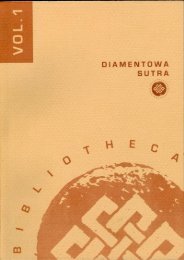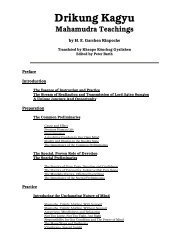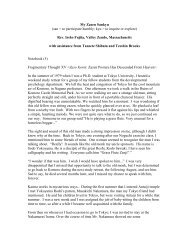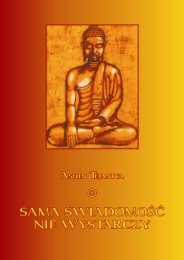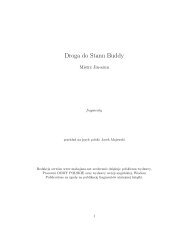3 - Computing in the Humanities and Social Sciences
3 - Computing in the Humanities and Social Sciences
3 - Computing in the Humanities and Social Sciences
You also want an ePaper? Increase the reach of your titles
YUMPU automatically turns print PDFs into web optimized ePapers that Google loves.
senjimon), was compiled by Yiij<strong>in</strong>g (635-713) toward <strong>the</strong> end of <strong>the</strong> seventh century.<br />
However, this important work is a list of Sanskrit words (it does not conta<strong>in</strong> sentences)<br />
written <strong>in</strong> Ch<strong>in</strong>ese transliteration: aga<strong>in</strong>, no Sanskrit letters were used. We may<br />
conclude that dur<strong>in</strong>g all <strong>the</strong>se centuries, Indian <strong>and</strong> Central Asian characters were<br />
treated, coherently with st<strong>and</strong>ard Buddhist conceptions of language, as mere tools to<br />
transmit <strong>the</strong> sense of <strong>the</strong> spoken words of Buddha <strong>and</strong> o<strong>the</strong>r masters or to reproduce<br />
<strong>the</strong> sound of mantras. Indian characters do not appear to have had any specific<br />
significance beyond <strong>the</strong>se purely <strong>in</strong>strumental functions.<br />
This situation began to change with <strong>the</strong> emergence, toward <strong>the</strong> end of <strong>the</strong> seventh<br />
century, of a more systematic form of esoteric Buddhism, known <strong>in</strong> Ch<strong>in</strong>ese as <strong>the</strong><br />
Zhen’yan school (Jp. Sh<strong>in</strong>gon). The esoteric teach<strong>in</strong>gs, diffused <strong>in</strong> Ch<strong>in</strong>a by <strong>the</strong> three<br />
charismatic figures of Subhakarasiµha (Ch. Shanwuwei, 637-735), Vajrabodhi (Ch.<br />
J<strong>in</strong>ggangzhi, 669-741), <strong>and</strong> Amoghavajra (Ch. Bukong, 705-774), attributed a new <strong>and</strong><br />
special status to writ<strong>in</strong>g. To <strong>the</strong>m, <strong>the</strong> transliterated sound of mantras was no longer<br />
enough; <strong>the</strong>y required a higher phonetic accuracy that could only be guaranteed by <strong>the</strong><br />
study of orig<strong>in</strong>al texts—<strong>and</strong>, <strong>the</strong>refore, of <strong>the</strong> Sanskrit writ<strong>in</strong>g system. One of <strong>the</strong> most<br />
strik<strong>in</strong>g features of <strong>the</strong> texts <strong>in</strong> <strong>the</strong> esoteric canon, <strong>in</strong> fact, is <strong>the</strong> presence of several<br />
passages written <strong>in</strong> Siddhaµ characters, ei<strong>the</strong>r mantric seeds or longer dhåra√∆,<br />
toge<strong>the</strong>r with <strong>the</strong>ir transliterations <strong>and</strong> explanations <strong>in</strong> Ch<strong>in</strong>ese. Fur<strong>the</strong>rmore, <strong>the</strong><br />
Zhen’yan school developed religious practices which <strong>in</strong>tegrated mantra chant<strong>in</strong>g <strong>and</strong><br />
<strong>the</strong> visualization of Siddhaµ characters <strong>in</strong> which <strong>the</strong> mantras were written. Thus,<br />
Siddhaµ, which until that moment were known only to a limited circle of experts<br />
engaged <strong>in</strong> translations, became an <strong>in</strong>dispensable subject of study for monks <strong>in</strong> general<br />
(at least, those <strong>in</strong>terested <strong>in</strong> esoteric Buddhism).<br />
The term xitan seems to have been used predom<strong>in</strong>antly dur<strong>in</strong>g <strong>the</strong> Tang period;<br />
<strong>the</strong> most common appellation <strong>in</strong> <strong>the</strong> Nor<strong>the</strong>rn Song dynasty was fanzhi (Jp. bonji), a<br />
translation of <strong>the</strong> Sanskrit Bråhm∆. Dur<strong>in</strong>g <strong>the</strong> Song period, however, <strong>the</strong> most used<br />
Indian characters <strong>in</strong> Ch<strong>in</strong>a were no longer <strong>the</strong> Gupta, but <strong>the</strong> Nagar∆. Even though <strong>the</strong><br />
use of Gupta-type xitan is reported until <strong>the</strong> M<strong>in</strong>g period (1368-1644), <strong>the</strong> Llan-tsa script<br />
of Indo-Tibetan orig<strong>in</strong> began to ga<strong>in</strong> prom<strong>in</strong>ence s<strong>in</strong>ce <strong>the</strong> Yuan period (1271-1341), to<br />
<strong>the</strong> po<strong>in</strong>t that by <strong>the</strong> Q<strong>in</strong>g period (1662-1912) it was <strong>the</strong> only writ<strong>in</strong>g system used <strong>in</strong><br />
Buddhist ritual <strong>in</strong> Ch<strong>in</strong>a. 16 Significantly, however, Indian characters used <strong>in</strong> Ch<strong>in</strong>a after<br />
16 On <strong>the</strong> history of <strong>the</strong> developments of Buddhist esoteric scripts <strong>in</strong> Ch<strong>in</strong>a, see Takubo <strong>and</strong><br />
Kanayama 1981.<br />
24


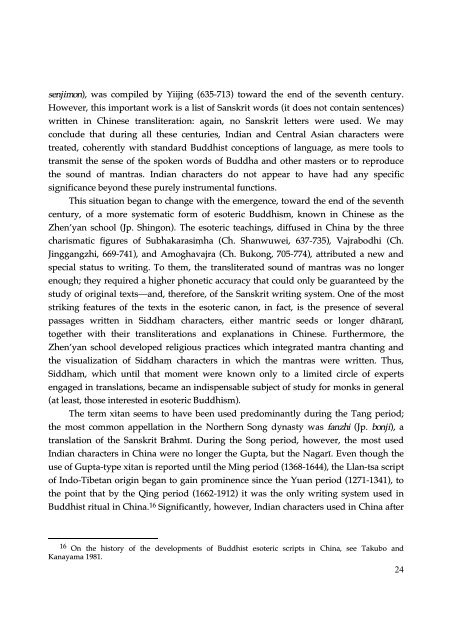
![Shushogi, Dogen Zenji [PDF] - Mahajana.net](https://img.yumpu.com/50921105/1/190x219/shushogi-dogen-zenji-pdf-mahajananet.jpg?quality=85)


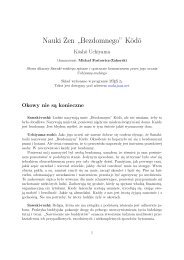

![wywiadu z Murakami Kosho Roshim [PDF] - Buddyzm w Polsce i na ...](https://img.yumpu.com/45809746/1/184x260/wywiadu-z-murakami-kosho-roshim-pdf-buddyzm-w-polsce-i-na-.jpg?quality=85)
